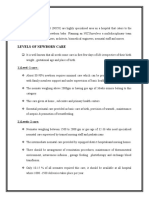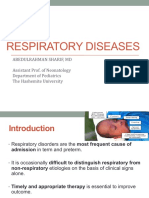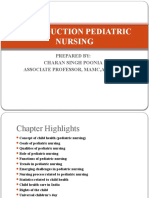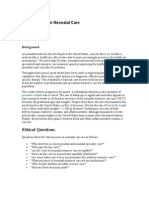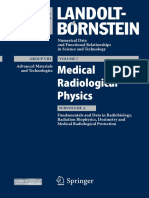Professional Documents
Culture Documents
Effectiveness of Planned Teaching Programme On Knowledge Regarding Identification of Danger Signs in Neonates Among Post-Natal Mothers
Original Title
Copyright
Available Formats
Share this document
Did you find this document useful?
Is this content inappropriate?
Report this DocumentCopyright:
Available Formats
Effectiveness of Planned Teaching Programme On Knowledge Regarding Identification of Danger Signs in Neonates Among Post-Natal Mothers
Copyright:
Available Formats
Volume 6, Issue 7, July – 2021 International Journal of Innovative Science and Research Technology
ISSN No:-2456-2165
Effectiveness of Planned Teaching Programme on
Knowledge Regarding Identification of Danger Signs
in Neonates among Post-Natal Mothers
Gamit Meghana Mahendrabhai
Sudheendra Mutalikadesai1
Address for correspondence: Sudheendra Mutalikadesai, Professor,SVBCON, Silvassa,
Dadra and Nagar haveli, India
Abstract:- care not only in the sub-Centre or PHCs, but also in the home
Introduction: Infants are very susceptible to get ill, mostly itself. But most important part is early identification of the
with infectious disease. Most of these illnesses can be illness after understanding the clinical feature of the disease.
managed by primary health care not only in the sub- Children are vital to the nation’s present and future. Healthy
Centre or PHCs, but also in the home itself. But most children are more likely to become healthy adults. Promotion
important part is early identification of the illness after of health today requires consideration of the hence the care of
understanding the clinical feature of the disease. Aim: children at birth plays a vital role. Early identification of new
The aim of the study was to determine the effectiveness of born danger signs by caregivers with prompt and appropriate
planned teaching programme on knowledge regarding referral serves as backbone of the programs aiming at
neonatal danger sings. Method: A pre-experimental reduction in neonatal mortality. The danger signs recognized
design was used for the study and 60 Postnatal mothers by WHO could indicate a severe disease or a local infection.
were selected by purposive sampling technique. Result: Early identification of a sick new born is the key to successful
Findings of the study revealed that the overall posttest management and improving neonatal outcome. The research
mean score was 18.88 with standard deviation 3.147 and investigator will look to the following danger sign in
the responded knowledge were significantly higher than neonates: hyperthermia/hypothermia, diarrhea, poor feeding
the overall mean pretest knowledge scores 11.20 with and vomiting, breathing difficulty, convulsion, jaundice,
standard deviation 3.172. Conclusion: The present study neonatal infection and lethargy. Apart from the all above
findings indicate that planned teaching programme was a factors, the investigator’s personal experience during clinical
suitable and effective method of enhancing the knowledge. postings made to select the study on the identification of
There was a significant difference between the Pre and danger signs in neonates. This study may strengthen on
Post test score categories of Knowledge. Therefore, we importance of the knowledge regarding the above said
can say that the intervention was very effective. problem and to prevent morbidity and mortality concerned to
the same.
Keywords:- Knowledge, Postnatal Mothers, Neonates,
Planned Teaching Programme (PTP). II.METHODS AND MATERIALS
I.INTRODUCTION Method
In this study, a quantitative research approach was
The birth of an infant is one of the most awe-inspiring adopted. A pre-experimental one group pre-test -post-test
and emotional events than can occur in one’s lifetime. After 9 designed was used. In this study group was given planned
months of anticipation and preparation, the neonate arrives teaching programme (prepared by the investigator) about
amid a flurry of excitement. The new human beings affect the danger signs in neonates. For this 60 sample (postnatal primi
lives of the parents and the other family members. Some mothers) were selected from shri vinoba bhave civil hospital.
parents and families adjust easily to the necessary changes in All selected have fulfilled the inclusion criteria and were the
their lifestyle, whereas others find it difficult to cope with selected by non-probability purposive sampling technique.
these changes and feel varying degrees of turmoil and
anxiety. This is especially true if the neonate is not the robust, Material
healthy, lovable infants who was expected. Neonatal periods A self-structured questionnaire consists of 30 items
from birth to 28 day of life. First week of life (<7 days or used to assess the knowledge regarding identification of
<168 hours) is known as early neonatal period. Late neonatal danger signs in neonates among postnatal primi mothers
period extends from 7th to <28th day. The most determinant admitted in post-natal ward at shri vinoba bhave civil hospital
time for a neonate survival period is 28th days of life. It’s Silvassa.
continuing to accelerate the reduction in under five mortality,
focusing on neonate should be a primarily concern.4Infants
are very susceptible to get ill, mostly with infectious disease.
Most of these illnesses can be managed by primary health
IJISRT21JUL708 www.ijisrt.com 756
Volume 6, Issue 7, July – 2021 International Journal of Innovative Science and Research Technology
ISSN No:-2456-2165
Section Topic Item Max. Sr. No Level of knowledge Score Percentage (%)
score 1 Poor 0-15 <50
1 Information regarding neonates 4 4 2 Average 16-22 50-75
2 Hyperthermia/hypothermia 5 5 3 Good 23-30 >75
3 Diarrhea 4 4 Table :2 Scoring according to level of knowledge
4 Breathing difficulties 3 3
5 Poor feeding 4 4 Ethical Consideration
6 Convulsion 3 3 Ethical clearance was obtained from the institutional
7 Jaundice 2 2 ethical committee of Shri Vinoba Bhave College of Nursing,
8 Neonatal infection 3 3 Silvassa. Administrative permission was taken from the
9 Lethargy 2 2 director, Medical and Health Services, Dadra And Nagar
Total 30 30 Haveli and Informed written consent was taken from the
study participants.
Table:1 description of knowledge questionnaire
III.FINDINGS OF THE STUDY
Scoring
Tool consists of total 30 items. Each question has only
Data was analyzed by using descriptive and inferential
one correct response. Each correct response given one mark
statistics.
and for wrong response given zero mark. Total minimum
score is zero and maximum score is 30.
Findings of Respondent on Pretest and Post-Test
Knowledge Level on Identification of Danger Signs in
Neonates.
Sr. No. Knowledge aspect Statement Max score Respondents knowledge
Mean Mean (%) SD
1 General information on neonates 4 4 2.17 54.24 1.011
2 Knowledge on hyper/hypothermia 5 5 1.68 33.6 1.066
3 Knowledge on diarrhea 4 4 1.25 31.25 0.932
4 Knowledge on feeding problems 3 3 1.07 35.66 1.071
5 Knowledge on breathing difficulties 4 4 1.03 25.75 0.843
6 Knowledge on convulsion 3 3 0.77 25.66 0.789
7 Knowledge on jaundice 2 2 1.43 71.5 0.563
8 Knowledge on neonatal infection 3 3 1.13 37.66 0.724
9 Knowledge on lethargy 2 2 .67 33.5 0.655
10 Combined 30 30 11.16 37.2 7.654
Table:3 Area wise and overall Mean, Mean Percentage and SD, regarding postnatal mothers on identification of danger
signs in neonates.
n=60
The table 3 displays that area wise and overall pretest on neonates (54.24%), neonatal infection (37.66%), feeding
mean, mean% and SD regarding identification of neonatal problems (35.66%), hyper/hypothermia and lethargy (33.6%
danger signs. It shows majority of postnatal mothers (71.5 %) & 33.5%), diarrhea (31.25%), and minimum (25.66%) on
had knowledge on jaundice, followed by general information breathing difficulties and on convulsion (25.75 %).
Sr. No. Knowledge aspect Statement Max score Respondents knowledge
Mean Mean (%) SD
1 General information on neonates 4 4 3.57 89.25 .593
2 Knowledge on hyper/hypo thermia 5 5 3.02 60.4 1.127
3 Knowledge on diarrhea 4 4 2.25 56.25 0.950
4 Knowledge on feeding problems 3 3 2.13 71 1.171
5 Knowledge on breathing difficulties 4 4 1.50 37.5 0.873
6 Knowledge on convulsion 3 3 1.80 60 0.898
7 Knowledge on jaundice 2 2 1.62 81 0.490
8 Knowledge on neonatal infection 3 3 1.95 65 0.769
9 Knowledge on lethargy 2 2 1.05 52.5 0.723
10 Combined 30 30 18.89 62.96 6.721
Table :4 Area wise and overall Mean, Mean Percentage and SD of post-test regarding postnatal mothers on identification
of danger signs in neonates
n=60
IJISRT21JUL708 www.ijisrt.com 757
Volume 6, Issue 7, July – 2021 International Journal of Innovative Science and Research Technology
ISSN No:-2456-2165
Table:4 shows the majority (89.25%) of the mothers neonatal infection (65%), hyper/hypo thermia and convulsion
had knowledge regarding general information on neonates (60%), diarrhea (56.25%), lethargy (52.5%) and lowest
followed by jaundice (81%), feeding problems (71%), knowledge on breathing difficulties (37.5%).
Score category Mean Mean % SD z-value p-value df Level of significance
Pre test 11.20 37.33 3.172 -6.959 0.001 59 0.05
Post test 18.88 62.93 3.147
Table:5 Mean, Mean %, SD and z-value of pretest and post-test knowledge score regarding postnatal mothers on
identification of danger signs in neonates
n=60
Note: significance at the level of 0.05
The above table depicts that obtained z is (Z (59,0.05=- test level of knowledge on danger sings in neonate among
6.959<0.001). Therefore, p- value is found to be higher than postnatal mothers accepted. This supports that the PTP was
the calculated value. Hence the research hypothesis stated effective in increasing the knowledge level of women
that there will be significant difference between pre and post- regarding danger signs in neonates
Sr. No Baseline characteristics Poor Average Chi Square value p-value df Significance
1 Age
<21 10 1
21-24 22 3 2.837 .585 4 NS
25-28 12 1
29-32 4 1
33-36 4 2
Education
Professional 1 1
Graduate 1 2
Post graduate 7 0 14.357 .026 6 S
2 Diploma 2 0
High school 10 3
Middle school 13 0
Primary school 18 2
Illiterate 0 0
Occupation
Technicians 1 1
Clerk 1 0 5.781 .566 7 NS
Skilled worker 2 0
3 Agriculture 2 0
Craft 1 1
Plant 1 0
Elementary 1 0
Unemployed 43 6
Type of family
4 Joint 16 3 .145 .703 1 NS
Nuclear 36 5
Extended 0 0
Family income
39,033-78062 1 0 7.541 .183 5 NS
29200-39032 2 2
5 19516-29199 5 2
11708-19515 18 2
3908-11707 22 2
<3907 4 0
Residence
6 Urban 6 5 12.027 .001 1 S
Rural 46 3
Religion
7 Hindu 39 7 1.224 .542 2 NS
Christian 7 0
IJISRT21JUL708 www.ijisrt.com 758
Volume 6, Issue 7, July – 2021 International Journal of Innovative Science and Research Technology
ISSN No:-2456-2165
Muslim 6 1
8 Delivery type
Normal 23 3 .128 .721 1 NS
LSCS 29 5
Previous knowledge
9. Yes 9 4 4.366 .037 1 S
No 43 4
Table :6 Association of pretest knowledge score of mothers with selected socio demographic variables
n=60
NOTE: - p≤0.05, S- Significance, NS-Non significant
Table:6 displays age, occupation type of family, family
income, religion and delivery samples does not have any
significant association with their pretest level of knowledge
about danger sings in neonates whereas the education of
mothers, residence and previous knowledge had a significant
association with the pretest level of knowledge of the study
sample.
IV.CONCLUSION
Planned teaching programme can enhance the
Knowledge of mothers regarding identification of danger
signs in neonate.
REFERENCES
[1]. Marlow’s textbook of “Pediatric Nursing”. South Asian
edition; Elsevier 2013: Kundli, Haryana. pp. (261, 425)
[2]. Wong’s and Heisley. Maternal-child nursing care,
optimizing outcomes for mothers, children &
families.1st Ed:2010. Jaypee brothers’ medical
publishers (p) ltd. Sanat printer. Pp 564.
[3]. Ghai “Essential pediatrics”, eight editions. CBS
publishers & distributors Pvt.Ltd,India; 2013. Pp.124.
[4]. UNICEF. Committing to child survival; Promise
renewed, 2014. Http//www.apromiserewed.org.
[5]. Sharma S. Essentials of pediatric nursing. 1st ed: Jaypee
brother’s publishers(p) ltd.2013 Haryana. Pp.71
[6]. IGNOU, ‘Newborn and Child Health Care’. BNS- 042
the people’s university 2017.dariyaganj. pp. 20
[7]. WHO recommendations on postnatal care of the mother
and new-born. 2013
[8]. 8.Shankar Prinja, Pankaj Bahuguna and et al. IMNCI
Program in district Faridabad
India.DOI:10.1371/journal.pone.0145043
January4,2016
[9]. UNICEF data, Under five mortality. 2019 September.
https// data.unicef.org>child survival>under five
mortality.
IJISRT21JUL708 www.ijisrt.com 759
You might also like
- The Ideal Neutropenic Diet Cookbook; The Super Diet Guide To Replenish Overall Health For A Vibrant Lifestyle With Nourishing RecipesFrom EverandThe Ideal Neutropenic Diet Cookbook; The Super Diet Guide To Replenish Overall Health For A Vibrant Lifestyle With Nourishing RecipesNo ratings yet
- Current StatusDocument14 pagesCurrent Statusthilaga88No ratings yet
- Management of Breast FeedingDocument17 pagesManagement of Breast FeedingUday KumarNo ratings yet
- Seminar ON: Baby Friendly Hospital InitiativeDocument7 pagesSeminar ON: Baby Friendly Hospital InitiativeUmairah BashirNo ratings yet
- Child Health Nursing-I - 201022Document8 pagesChild Health Nursing-I - 201022ShwetaNo ratings yet
- Health Edu. On Breast Feedind WASEEM-1Document7 pagesHealth Edu. On Breast Feedind WASEEM-1MysaraNo ratings yet
- Newborn CareDocument49 pagesNewborn CareJohn Mark PocsidioNo ratings yet
- A Study To Assess The Effectiveness of Structured Teaching Programme On Knowledge Regarding Management of Low Birth Weight LBW Babies Among Postnatal Mothers in Selected Community at GwaliorDocument7 pagesA Study To Assess The Effectiveness of Structured Teaching Programme On Knowledge Regarding Management of Low Birth Weight LBW Babies Among Postnatal Mothers in Selected Community at GwaliorEditor IJTSRDNo ratings yet
- New Born CareDocument19 pagesNew Born CarePARUL YADAVNo ratings yet
- Baby Friendly Hospital Initiative (Bfhi)Document9 pagesBaby Friendly Hospital Initiative (Bfhi)Ankita BramheNo ratings yet
- National Policy For ChildrenDocument5 pagesNational Policy For Childrenthilaga88No ratings yet
- Care of Low Birth WeightDocument21 pagesCare of Low Birth WeightPrernaSharmaNo ratings yet
- Intrauterine Growth RestrictionDocument27 pagesIntrauterine Growth RestrictionJorge La Serna InfantesNo ratings yet
- Orphanage HomeDocument6 pagesOrphanage HomeNitu GodaraNo ratings yet
- Healthy Newborn InfantDocument20 pagesHealthy Newborn InfantRAMAVATH SRINUNo ratings yet
- 'NicuDocument12 pages'NicuTopeshwar TpkNo ratings yet
- A Study To Assess The Effectiveness of Information Booklet On Knowledge Regarding Breastfeeding Techniques Among Primipara Mothers in Selected Hospitals at Bhopal M.P.Document8 pagesA Study To Assess The Effectiveness of Information Booklet On Knowledge Regarding Breastfeeding Techniques Among Primipara Mothers in Selected Hospitals at Bhopal M.P.Editor IJTSRDNo ratings yet
- Neonatal InfectionsDocument18 pagesNeonatal InfectionsSanthosh.S.U100% (1)
- FamilyDocument19 pagesFamilyVaishnavee Singh100% (1)
- Topic - Preventive Pediatrics Subject - Pediatrics Unit - IiDocument10 pagesTopic - Preventive Pediatrics Subject - Pediatrics Unit - IiDinesh KhinchiNo ratings yet
- Genetic Patterns of Common Pediatric DisordersDocument29 pagesGenetic Patterns of Common Pediatric DisordersramNo ratings yet
- Seminar On - Essential and Immediate Newborn CareDocument26 pagesSeminar On - Essential and Immediate Newborn CareJyothi Singh SuryavanshiNo ratings yet
- Educational Preparation & Continuing Nursing EducationDocument18 pagesEducational Preparation & Continuing Nursing EducationAnas khanNo ratings yet
- Bonding NewDocument23 pagesBonding NewPadmaNo ratings yet
- For Emergency Nursing Students: ImnciDocument114 pagesFor Emergency Nursing Students: ImnciChalie MequanentNo ratings yet
- Report of Inservice EducationDocument35 pagesReport of Inservice EducationAkansha JohnNo ratings yet
- CPR For Children and Infants: Cardiopulmonary ResuscitationDocument2 pagesCPR For Children and Infants: Cardiopulmonary Resuscitationjanna mae patriarcaNo ratings yet
- Respiratory Diseases GuideDocument58 pagesRespiratory Diseases GuideSarahNo ratings yet
- 84 Vaccine Preventable Diseases and Immunization Programs FINAL 0 PDFDocument91 pages84 Vaccine Preventable Diseases and Immunization Programs FINAL 0 PDFhassanNo ratings yet
- Key Concepts MediaDocument20 pagesKey Concepts MediaaparnaNo ratings yet
- Neonatal JaundiceDocument36 pagesNeonatal JaundiceJenaffer Achamma JohnNo ratings yet
- 17 FBNC Guidelines Part 2Document68 pages17 FBNC Guidelines Part 2Sameer PatelNo ratings yet
- Breast FeedingDocument28 pagesBreast FeedingAnadh PatelNo ratings yet
- The Term NewbornDocument24 pagesThe Term NewbornshwetaliNo ratings yet
- Introduction To Pediatric NursingDocument36 pagesIntroduction To Pediatric Nursingcharan poonia100% (1)
- The Joint Committee On Health Education and Promotion Terminology of 2001 Defined Health Education As "AnyDocument8 pagesThe Joint Committee On Health Education and Promotion Terminology of 2001 Defined Health Education As "AnyRaman SamraoNo ratings yet
- Assignment of Battered ChildDocument6 pagesAssignment of Battered Childcharanjit kaurNo ratings yet
- 1.1, 1.2, 1.3, 1.5 Paediatric Nursing Presentation - 1-1Document54 pages1.1, 1.2, 1.3, 1.5 Paediatric Nursing Presentation - 1-1Christina YounasNo ratings yet
- Essential Infant Nutrition: Benefits of Exclusive BreastfeedingDocument11 pagesEssential Infant Nutrition: Benefits of Exclusive BreastfeedingRosa PalconitNo ratings yet
- Breast FeedingDocument33 pagesBreast Feedingjulie kisku100% (1)
- UNIT II Growth & DevelopmemtDocument110 pagesUNIT II Growth & DevelopmemtSifanaNo ratings yet
- Exclusivebreastfeeding 181003124754Document39 pagesExclusivebreastfeeding 181003124754apalanavedNo ratings yet
- Newborn Capillary Blood CollectionDocument3 pagesNewborn Capillary Blood CollectionYwagar YwagarNo ratings yet
- My ThesisDocument46 pagesMy ThesisManish SharmaNo ratings yet
- Ethical Issues in NeonateDocument11 pagesEthical Issues in Neonatethilaga880% (1)
- INTRODUCTIONDocument26 pagesINTRODUCTIONTina Manoj100% (1)
- Factors Influencing LearningDocument17 pagesFactors Influencing Learningnirajan shresthaNo ratings yet
- Postmature Infants 1Document13 pagesPostmature Infants 1LyssaMarieKathryneEge100% (1)
- IMNCIDocument47 pagesIMNCIRenuga SureshNo ratings yet
- A Study To Evaluate The Effectiveness of Structured Teaching Program On Knowledge and Practice Regarding Kangaroo Mother Care Among Post Natal Mothers Having Low Birth Weight Babies 1Document9 pagesA Study To Evaluate The Effectiveness of Structured Teaching Program On Knowledge and Practice Regarding Kangaroo Mother Care Among Post Natal Mothers Having Low Birth Weight Babies 1Manisa ParidaNo ratings yet
- Need of New Born and Parenting ProcessDocument13 pagesNeed of New Born and Parenting ProcessKrini TandelNo ratings yet
- Review of Systems Checklist for Pediatric Physical ExamDocument2 pagesReview of Systems Checklist for Pediatric Physical ExamteuuuuNo ratings yet
- 1.microteaching On Curiculum CommitteeDocument14 pages1.microteaching On Curiculum CommitteeReshma rsr100% (1)
- Nenotal Hypoglycemia and HypocalcemiaDocument3 pagesNenotal Hypoglycemia and HypocalcemiabhawnaNo ratings yet
- Baby Friendly HospitalDocument42 pagesBaby Friendly HospitalblessyNo ratings yet
- Minordisordersofbnewborn 161129154708Document33 pagesMinordisordersofbnewborn 161129154708Kevin Daniel GoveasNo ratings yet
- LESSON PLAN On Paedritric Nurse RolesDocument3 pagesLESSON PLAN On Paedritric Nurse Rolesbuhari rabiuNo ratings yet
- Challenges of Neonatal Transport in Developing CountriesDocument19 pagesChallenges of Neonatal Transport in Developing CountriesNeha OberoiNo ratings yet
- Preventive Pediatrics: Understanding Nutrition and Fluid Management in ChildrenDocument82 pagesPreventive Pediatrics: Understanding Nutrition and Fluid Management in ChildrenYashoda Satpute100% (1)
- Nursing Assignment on Hemorrhage and Shock PathophysiologyDocument22 pagesNursing Assignment on Hemorrhage and Shock PathophysiologyaparnaNo ratings yet
- Automatic Power Factor ControllerDocument4 pagesAutomatic Power Factor ControllerInternational Journal of Innovative Science and Research TechnologyNo ratings yet
- Intelligent Engines: Revolutionizing Manufacturing and Supply Chains with AIDocument14 pagesIntelligent Engines: Revolutionizing Manufacturing and Supply Chains with AIInternational Journal of Innovative Science and Research TechnologyNo ratings yet
- Navigating Digitalization: AHP Insights for SMEs' Strategic TransformationDocument11 pagesNavigating Digitalization: AHP Insights for SMEs' Strategic TransformationInternational Journal of Innovative Science and Research TechnologyNo ratings yet
- A Review: Pink Eye Outbreak in IndiaDocument3 pagesA Review: Pink Eye Outbreak in IndiaInternational Journal of Innovative Science and Research TechnologyNo ratings yet
- Teachers' Perceptions about Distributed Leadership Practices in South Asia: A Case Study on Academic Activities in Government Colleges of BangladeshDocument7 pagesTeachers' Perceptions about Distributed Leadership Practices in South Asia: A Case Study on Academic Activities in Government Colleges of BangladeshInternational Journal of Innovative Science and Research TechnologyNo ratings yet
- Securing Document Exchange with Blockchain Technology: A New Paradigm for Information SharingDocument4 pagesSecuring Document Exchange with Blockchain Technology: A New Paradigm for Information SharingInternational Journal of Innovative Science and Research TechnologyNo ratings yet
- Mobile Distractions among Adolescents: Impact on Learning in the Aftermath of COVID-19 in IndiaDocument2 pagesMobile Distractions among Adolescents: Impact on Learning in the Aftermath of COVID-19 in IndiaInternational Journal of Innovative Science and Research TechnologyNo ratings yet
- Studying the Situation and Proposing Some Basic Solutions to Improve Psychological Harmony Between Managerial Staff and Students of Medical Universities in Hanoi AreaDocument5 pagesStudying the Situation and Proposing Some Basic Solutions to Improve Psychological Harmony Between Managerial Staff and Students of Medical Universities in Hanoi AreaInternational Journal of Innovative Science and Research TechnologyNo ratings yet
- Review of Biomechanics in Footwear Design and Development: An Exploration of Key Concepts and InnovationsDocument5 pagesReview of Biomechanics in Footwear Design and Development: An Exploration of Key Concepts and InnovationsInternational Journal of Innovative Science and Research TechnologyNo ratings yet
- Perceived Impact of Active Pedagogy in Medical Students' Learning at the Faculty of Medicine and Pharmacy of CasablancaDocument5 pagesPerceived Impact of Active Pedagogy in Medical Students' Learning at the Faculty of Medicine and Pharmacy of CasablancaInternational Journal of Innovative Science and Research TechnologyNo ratings yet
- Formation of New Technology in Automated Highway System in Peripheral HighwayDocument6 pagesFormation of New Technology in Automated Highway System in Peripheral HighwayInternational Journal of Innovative Science and Research TechnologyNo ratings yet
- Natural Peel-Off Mask Formulation and EvaluationDocument6 pagesNatural Peel-Off Mask Formulation and EvaluationInternational Journal of Innovative Science and Research TechnologyNo ratings yet
- Drug Dosage Control System Using Reinforcement LearningDocument8 pagesDrug Dosage Control System Using Reinforcement LearningInternational Journal of Innovative Science and Research TechnologyNo ratings yet
- The Effect of Time Variables as Predictors of Senior Secondary School Students' Mathematical Performance Department of Mathematics Education Freetown PolytechnicDocument7 pagesThe Effect of Time Variables as Predictors of Senior Secondary School Students' Mathematical Performance Department of Mathematics Education Freetown PolytechnicInternational Journal of Innovative Science and Research TechnologyNo ratings yet
- Enhancing the Strength of Concrete by Using Human Hairs as a FiberDocument3 pagesEnhancing the Strength of Concrete by Using Human Hairs as a FiberInternational Journal of Innovative Science and Research TechnologyNo ratings yet
- Supply Chain 5.0: A Comprehensive Literature Review on Implications, Applications and ChallengesDocument11 pagesSupply Chain 5.0: A Comprehensive Literature Review on Implications, Applications and ChallengesInternational Journal of Innovative Science and Research TechnologyNo ratings yet
- Advancing Opthalmic Diagnostics: U-Net for Retinal Blood Vessel SegmentationDocument8 pagesAdvancing Opthalmic Diagnostics: U-Net for Retinal Blood Vessel SegmentationInternational Journal of Innovative Science and Research TechnologyNo ratings yet
- The Making of Self-Disposing Contactless Motion-Activated Trash Bin Using Ultrasonic SensorsDocument7 pagesThe Making of Self-Disposing Contactless Motion-Activated Trash Bin Using Ultrasonic SensorsInternational Journal of Innovative Science and Research TechnologyNo ratings yet
- Placement Application for Department of Commerce with Computer Applications (Navigator)Document7 pagesPlacement Application for Department of Commerce with Computer Applications (Navigator)International Journal of Innovative Science and Research TechnologyNo ratings yet
- REDLINE– An Application on Blood ManagementDocument5 pagesREDLINE– An Application on Blood ManagementInternational Journal of Innovative Science and Research TechnologyNo ratings yet
- Beyond Shelters: A Gendered Approach to Disaster Preparedness and Resilience in Urban CentersDocument6 pagesBeyond Shelters: A Gendered Approach to Disaster Preparedness and Resilience in Urban CentersInternational Journal of Innovative Science and Research TechnologyNo ratings yet
- Exploring the Clinical Characteristics, Chromosomal Analysis, and Emotional and Social Considerations in Parents of Children with Down SyndromeDocument8 pagesExploring the Clinical Characteristics, Chromosomal Analysis, and Emotional and Social Considerations in Parents of Children with Down SyndromeInternational Journal of Innovative Science and Research TechnologyNo ratings yet
- Handling Disruptive Behaviors of Students in San Jose National High SchoolDocument5 pagesHandling Disruptive Behaviors of Students in San Jose National High SchoolInternational Journal of Innovative Science and Research TechnologyNo ratings yet
- Safety, Analgesic, and Anti-Inflammatory Effects of Aqueous and Methanolic Leaf Extracts of Hypericum revolutum subsp. kenienseDocument11 pagesSafety, Analgesic, and Anti-Inflammatory Effects of Aqueous and Methanolic Leaf Extracts of Hypericum revolutum subsp. kenienseInternational Journal of Innovative Science and Research TechnologyNo ratings yet
- A Curious Case of QuadriplegiaDocument4 pagesA Curious Case of QuadriplegiaInternational Journal of Innovative Science and Research TechnologyNo ratings yet
- A Knowledg Graph Model for e-GovernmentDocument5 pagesA Knowledg Graph Model for e-GovernmentInternational Journal of Innovative Science and Research TechnologyNo ratings yet
- Analysis of Financial Ratios that Relate to Market Value of Listed Companies that have Announced the Results of their Sustainable Stock Assessment, SET ESG Ratings 2023Document10 pagesAnalysis of Financial Ratios that Relate to Market Value of Listed Companies that have Announced the Results of their Sustainable Stock Assessment, SET ESG Ratings 2023International Journal of Innovative Science and Research TechnologyNo ratings yet
- Pdf to Voice by Using Deep LearningDocument5 pagesPdf to Voice by Using Deep LearningInternational Journal of Innovative Science and Research TechnologyNo ratings yet
- Adoption of International Public Sector Accounting Standards and Quality of Financial Reporting in National Government Agricultural Sector Entities, KenyaDocument12 pagesAdoption of International Public Sector Accounting Standards and Quality of Financial Reporting in National Government Agricultural Sector Entities, KenyaInternational Journal of Innovative Science and Research TechnologyNo ratings yet
- Fruit of the Pomegranate (Punica granatum) Plant: Nutrients, Phytochemical Composition and Antioxidant Activity of Fresh and Dried FruitsDocument6 pagesFruit of the Pomegranate (Punica granatum) Plant: Nutrients, Phytochemical Composition and Antioxidant Activity of Fresh and Dried FruitsInternational Journal of Innovative Science and Research TechnologyNo ratings yet
- 60-JICR-OCOTOBER-2022Document5 pages60-JICR-OCOTOBER-2022abhaydkharatNo ratings yet
- (Landolt-Börnstein - Group VIII Advanced Materials and Technologies 7A _ Advanced Materials and Technologies) A. Kaul, J. H. Bernhardt, H. -M. Kramer (auth.), A. Kaul (eds.) - Fundamentals and Data in.pdfDocument353 pages(Landolt-Börnstein - Group VIII Advanced Materials and Technologies 7A _ Advanced Materials and Technologies) A. Kaul, J. H. Bernhardt, H. -M. Kramer (auth.), A. Kaul (eds.) - Fundamentals and Data in.pdfPrince Sandip GhoshNo ratings yet
- Detection of Land Subsidence in Kathmandu Valley NDocument17 pagesDetection of Land Subsidence in Kathmandu Valley NNetra Bahadur KatuwalNo ratings yet
- Sample Contextualized Localized DLLDocument14 pagesSample Contextualized Localized DLLJanine Espineda100% (1)
- Procedures For Using Lecia DNA03 Digital LevelDocument10 pagesProcedures For Using Lecia DNA03 Digital LevelAbdulwasi Salahudin100% (1)
- Calculation of The Equivalent Resistance and Impedance of The Cylindrical Network Based On Recursion-Transform MethodDocument12 pagesCalculation of The Equivalent Resistance and Impedance of The Cylindrical Network Based On Recursion-Transform Methodmark_990566444No ratings yet
- Easy UPS 3-Series Accessories - E3SBTH4Document2 pagesEasy UPS 3-Series Accessories - E3SBTH4Nguyễn Thanh TuấnNo ratings yet
- MGT544 Chapter 3 PerceptionDocument14 pagesMGT544 Chapter 3 PerceptionaidaarifahNo ratings yet
- Comparing Body Language and GesturesDocument3 pagesComparing Body Language and Gesturesoz asier cyrusNo ratings yet
- Integration Procedure of Telecom System WHP andDocument53 pagesIntegration Procedure of Telecom System WHP andselamet riantoNo ratings yet
- Crime Scene Decoders Algebra: Polynomials: Standard Focus: Time Range: Supplies: Topics of FocusDocument14 pagesCrime Scene Decoders Algebra: Polynomials: Standard Focus: Time Range: Supplies: Topics of Focusdrecosh-1No ratings yet
- Template 7 SlidesgoDocument34 pagesTemplate 7 Slidesgositi halimah ismailNo ratings yet
- Reaction PaperDocument1 pageReaction PaperIvy Jean PalamosNo ratings yet
- Area Bounded by CurvesDocument15 pagesArea Bounded by CurvesJulius JunioNo ratings yet
- Reading Journal LogDocument1 pageReading Journal LogFrederick EspejoNo ratings yet
- B Tech Csbs Syllabus 2018 19Document96 pagesB Tech Csbs Syllabus 2018 19Ritu AhluwaliaNo ratings yet
- Leo Strauss EsoterismoDocument24 pagesLeo Strauss EsoterismoBruno LazarinhoNo ratings yet
- Bw30xfrle-400 34Document2 pagesBw30xfrle-400 34Alejandro OdioNo ratings yet
- Purposive Comm 9-8-22Document26 pagesPurposive Comm 9-8-22Jazzyl ParanNo ratings yet
- Marie Louise Von Franz Alchemy PDFDocument35 pagesMarie Louise Von Franz Alchemy PDFLFF57100% (1)
- Thời gian làm bài: 180 phút (không kể thời gian giao đề)Document5 pagesThời gian làm bài: 180 phút (không kể thời gian giao đề)Jennifer WatsonNo ratings yet
- SMCPP - Sample Project DescDocument26 pagesSMCPP - Sample Project DescManna PintoNo ratings yet
- Ps3 Unit 8 Lesson 1 Period 2Document6 pagesPs3 Unit 8 Lesson 1 Period 2Quách Thi NhungNo ratings yet
- კემპბელი თ16 353 363 დნმ და რეპლიკაციაDocument11 pagesკემპბელი თ16 353 363 დნმ და რეპლიკაციაSosoNo ratings yet
- SECTION 21 - MicropilingDocument8 pagesSECTION 21 - MicropilingTony JamesNo ratings yet
- The Scientific Study of Mind and BehaviorDocument77 pagesThe Scientific Study of Mind and BehaviorVenkatesh GaduputiNo ratings yet
- ISO 13852 Upper Body Reach LimitsDocument15 pagesISO 13852 Upper Body Reach LimitsallanfosterNo ratings yet
- Dynamic Model of CondenserDocument10 pagesDynamic Model of CondenserJung Kyung WooNo ratings yet
- Behaviors and S-WPS OfficeDocument3 pagesBehaviors and S-WPS OfficeFritz Vonn BulabonNo ratings yet
- 3 RdgradereadingcomprehensionpassageandquestionsetDocument7 pages3 Rdgradereadingcomprehensionpassageandquestionsetapi-369806954No ratings yet















